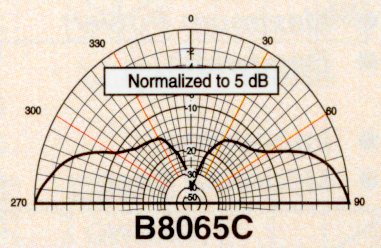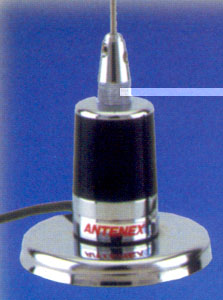B8065 5 bd gain antenna
radiation pattern -
more power lower to the horizon
magnetic mount base



Cellular Data Link CDL 900 Cell Modem |
Cellular Wireless Access Solution.
cellular
modem access solution
(looks and feels like a standard RS
232 AT command compatible modem)
AC or DC power, -30 to +75C temperature rating option
This low cost
combination of a modem &
Cell phone is ideal for those
" remote" sites where a copper phone line is impossible.
With the cost of cellular service declining a cell modem makes sense for more and more remote site applications .
The C
DL-900 is designed around the Radio CRM 4100 from Standard Communications. Once interfaced with the 4100, to the user, the entire unit looks like a standard RS 232 AT command compatible modem. This allows compatibility with popular software packages.jump to Related pages - jump to Cellular Modems
Sample Application Areas
Specfications
Your package includes:
What you need to provide:
Installation:
Contact your cellular service provider and register the unit. To register the unit and get service, you will need to provide the cellular operator the ESN number (this is on the label at the top) and also tell them that the unit is class 3 unit (power 600 mw).
The cellular operator will, in turn, provide you:
It is recommended that MIN number be entered in label on the unit.
First Time Quick Start
(The CM900 is configured as a DCE (e.g. modem). It talks to a PC through the RS 232 cable.)
1) Connect the power supply. The Power LED should be on. Connect the RS 232 cable provided. Connect the Antenna. The unit is ready for operation.
2) Configure the serial port to 9600 bps, 8N1 and Hardware Handshaking.
3) Allow 10 seconds for calibration.
4)
Enter AT+TEST<CR>. The unit will respond OK.5) Enter AT+MIN=< the MIN allocated><enter> The unit will respond OK.
6) Enter AT+SID=< the SID allocated><enter> The unit will respond OK
7) Enter AT+SYS=00 <CR> (for system B only)
=01 <CR> (for system A only)
=02 <CR>
(SID will determine preferred system, but roaming charge may apply.
This is also called normal mode)
8) Enter AT+MODE=02<CR> The unit is now set for data mode.
9) Enter AT+SER? <CR> The unit should respond with SERVICE AVAILABLE.
Please note that radio does NOT have to configured every-time. The above information is stored in the Radio’s non-volatile memory.
Operation:
The CM900 (hereafter referred to as modem) is always in one of the two states: the command state or the on-line state. The modem assumes the Command State when power is applied. This state allows the modem to be configured for the particular application. In the Command State, all inputs from the PC are treated as commands. The modem may be set to the on-line state in which all inputs form the PC are treated as data to be shipped over the airwaves and all inputs from the airwaves is treated as received data from the remote end.
jump to PDF file of manual
jump to DOC file of manual
Base Station Omni Antenna |
OD4-900 4db gain $105.00 |
Base Station Yagi Antenna |
YAG6-900 T or N 6db gain $75.00 |
|
We have many more configurations available |
|
B8065 5 bd gain antenna |
radiation pattern - |
magnetic mount base |
 |
|
 |
|
WARNING: |
TO PREVENT DAMAGE, SERIOUS
INJURY, OR EVEN DEATH, NEVER INSTALL AN ANTENNA NEAR HIGH VOLTAGE POWER
LINES. |
6.1
Antenna Installation Instructions
Another gain factor is the way the radiation pattern lays down on the horizon - with more power - lower to the horizon - the transceiver has a more effective gain to the cellular system tower.

Yagi
For a very
remote installation, a directional antenna (may be desired. This type of antenna concentrates the transmitted power in
the direction it is pointed. These
antennas can be designed to have a wide “beam-width” or a narrow
“beam-width”. The narrower the
“beam-width”, the higher the gain of the antenna.
It is critical that
directional antennas be pointed directly at the cell site. The direction of the nearest cell site can be determined by
contacting the cellular carrier for your area.
6.2
Antenna Installation Guidelines
·
the distance
to the nearest cell site
·
the degree
of down-tilt used on the cell site antenna array
·
the type of
terrain and foliage between the antenna and cell site
·
the
existence of man-made obstacles such as buildings and/or water towers between
the antenna and cell site or radio interference.
·
the distance
between the Cell modem antenna
placement
·
the height
of the antenna above ground level
· the type and length of cable used to attach the antenna to the Cell modem
6.2.1 Know
the location(s) of the closest cell site(s).
The cellular carrier can provide the appropriate location information.
This information will assist you in positioning antennas and enable you
to do a path check between the cell site and your location for any man-made or
natural obstacles. 6.2.2
Man-made
and natural obstacles such as buildings, water towers, mountains, hills and
trees can cause the cellular signal to deteriorate or even block the signal.
Raising the antenna, relocating the antenna, or choosing a higher gain
antenna may improve reception. 6.2.4
The
type and placement needs of the antenna can vary significantly over a small
distance (as little as a few feet horizontally and/or vertically), so different
antenna placement locations should be tried if a high quality connection between
the cellular system and the Cell modem is not established or ahs a high error
rate. 6.2.5
Always
elevate the antenna as high as possible so that it has a clear path to the cell
site. 6.2.6
If
the installation location is well within the range of the cell site, a unity
gain antenna or a 3dB gain antenna should be sufficient for an acceptable signal
strength. However, if the installation is on the “fringe” or just outside
the range of the cell site, a higher gain, directional antenna may be needed to
establish an acceptable connection. 6.2.7
The
antenna cable should be laid as straight as possible with no kinks, twists or
bends. If the cable has be to coiled, keep the radius of the coils as large as
possible. 6.2.8
The
antenna and cable should be as far away from any other transmission sources as
possible to minimize potential interference from those sources.
Other transmission sources include other antennas, radio frequency (RF)
generators and AC power lines. 6.2.9
If
attempts to establish a high quality connection are unsuccessful, relocation of
the entire installation may be necessary. Prior
to moving the entire installation, attempt to access a different cell site
through the use of directional high gain antenna.
Even though the cell site may be farther away, the different direction
may avoid man-made or natural obstacles that are blocking the cellular signal. 6.2.10 Remember
that while the distance that the Cell modem unit can be from the antenna is limited,
the distance from the CS-832 to the meter/telephone equipment to which it is
connected can be 1000 feet or more. Thus,
the Cell modem does not have to be located with the meter/telephone equipment to
function properly. This aspect of
the equipment gives significant additional flexibility in the installation
process. 6.2.11
No
matter what type of antenna is being used, propagation patterns vary, as does
reception. You may want to try
different locations to achieve the best results, even if a given location
appears adequate. Once the best
antenna type and location is determined, permanently mount the antenna. Elevated Feed Omni
antennas are designed for most cellular installations. These antennas can be mounted under a variety of scenarios and
will provide adequate signal strength for data applications in most areas.
You
should use an antenna that does not require a ground plane and should be mounted as
high as possible with a direct line of sight to the nearest cellular site with
the shortest coax lead possible. Mount
the antenna VERTICALLY on a solid surface in a location so that its perimeter is
clear of any metal objects and/or obstacles. Yagi Point the antenna towards the cell site.
Make sure the elements (the bars on the antenna) are positioned
vertically. It should be in a location so that the transmission path is
clear of any nearby metal objects and/or obstacles. jump to Mobil
antennas
ARC ELECTRONICS
a DCE Company
301-924-7400 EXT 25 x 17
e-mail Sales at drowe@data-connect.com
jump to ... Home Page